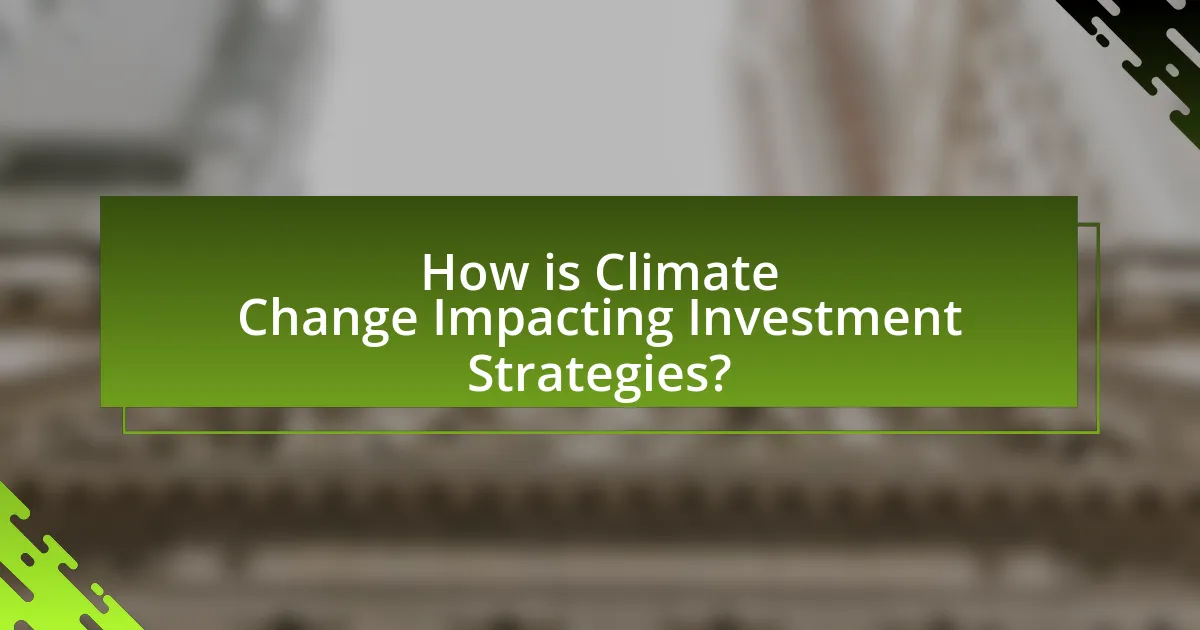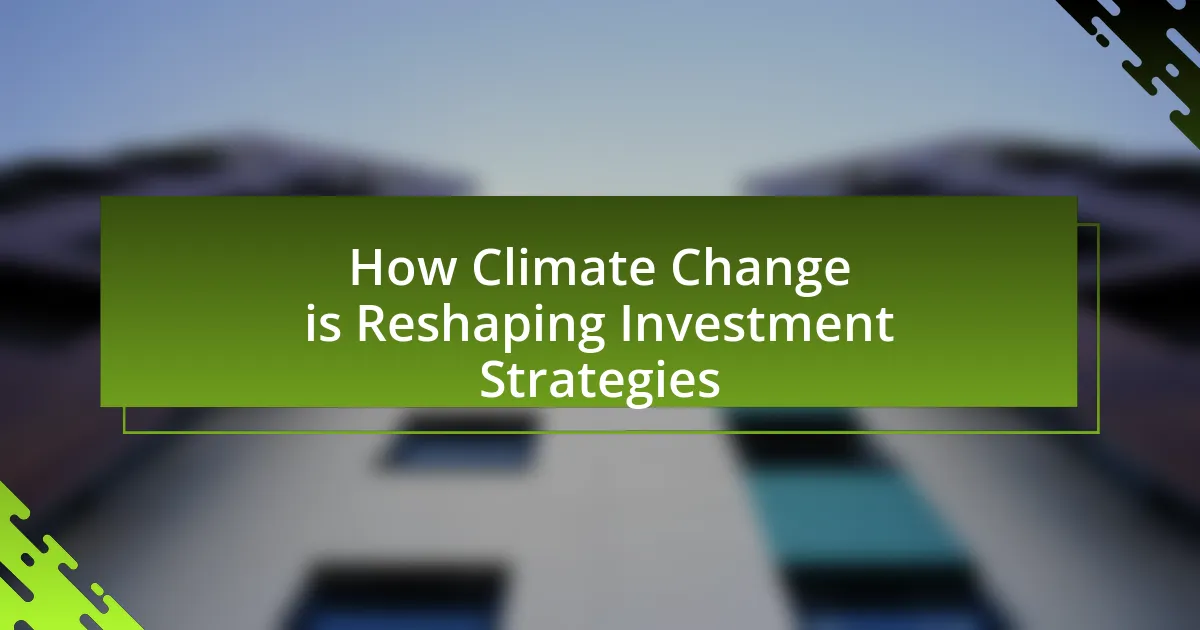Climate change is fundamentally reshaping investment strategies as investors increasingly prioritize sustainable and environmentally responsible investments. The article explores the significant rise in global sustainable investment, driven by regulatory pressures, shifting consumer preferences, and the physical risks associated with climate impacts. It highlights the importance of integrating Environmental, Social, and Governance (ESG) criteria into investment decisions, the financial risks of ignoring climate change, and the emerging opportunities in renewable energy and sustainable technologies. Additionally, it discusses various approaches to sustainable investing, the role of government policies, and practical steps investors can take to align their strategies with climate-conscious objectives.

How is Climate Change Impacting Investment Strategies?
Climate change is significantly impacting investment strategies by driving a shift towards sustainable and environmentally responsible investments. Investors are increasingly prioritizing Environmental, Social, and Governance (ESG) criteria, as evidenced by a 2021 report from the Global Sustainable Investment Alliance, which indicated that global sustainable investment reached $35.3 trillion, a 15% increase from 2018. This trend reflects a growing recognition that climate risks can affect financial performance, prompting investors to assess the long-term viability of companies based on their environmental impact. Additionally, regulatory changes and consumer preferences are pushing firms to adopt greener practices, further influencing investment decisions.
What are the key factors driving changes in investment strategies due to climate change?
The key factors driving changes in investment strategies due to climate change include regulatory pressures, shifting consumer preferences, and the increasing physical risks associated with climate impacts. Regulatory pressures, such as the European Union’s Sustainable Finance Disclosure Regulation, compel investors to consider environmental risks in their portfolios. Shifting consumer preferences towards sustainable products and services lead companies to adopt greener practices, influencing investment decisions. Additionally, the increasing physical risks from climate change, such as extreme weather events, prompt investors to reassess the viability of certain assets, as evidenced by the $1 trillion in losses projected for the global economy due to climate-related disasters by 2030. These factors collectively drive a transition towards more sustainable and resilient investment strategies.
How do regulatory changes influence investment decisions related to climate change?
Regulatory changes significantly influence investment decisions related to climate change by altering the risk and return profiles of investments. For instance, stricter emissions regulations can lead to increased operational costs for high-polluting industries, prompting investors to shift their capital towards cleaner technologies and renewable energy sources. A study by the Global Sustainable Investment Alliance reported that sustainable investment assets reached $30.7 trillion in 2020, reflecting a growing trend influenced by regulatory frameworks promoting environmental sustainability. Additionally, government incentives for green investments, such as tax credits and subsidies, further encourage capital allocation towards climate-friendly projects, reinforcing the impact of regulatory changes on investment strategies.
What role do consumer preferences play in reshaping investment strategies?
Consumer preferences significantly influence the reshaping of investment strategies, particularly in the context of climate change. As consumers increasingly prioritize sustainability and environmentally friendly products, investors are compelled to align their portfolios with these preferences to mitigate risks and capitalize on emerging opportunities. For instance, a 2021 survey by McKinsey found that 70% of consumers are willing to pay more for sustainable products, prompting companies to adopt greener practices and investors to favor businesses that demonstrate environmental responsibility. This shift in consumer behavior drives capital towards sustainable investments, thereby reshaping the overall investment landscape to reflect a growing demand for climate-conscious initiatives.
Why is it important for investors to consider climate change in their strategies?
Investors must consider climate change in their strategies because it significantly impacts financial performance and risk management. Climate change poses physical risks to assets, such as extreme weather events that can damage infrastructure and disrupt supply chains, leading to financial losses. Additionally, regulatory changes aimed at mitigating climate change can affect industries, with sectors like fossil fuels facing increased scrutiny and potential devaluation. According to the Global Risks Report 2021 by the World Economic Forum, environmental risks, including climate change, are among the top global risks in terms of likelihood and impact. Therefore, integrating climate considerations into investment strategies is essential for safeguarding investments and capitalizing on emerging opportunities in sustainable sectors.
What risks do investors face if they ignore climate change?
Investors face significant financial risks if they ignore climate change, including asset devaluation, regulatory penalties, and reputational damage. Climate change can lead to extreme weather events, which may disrupt supply chains and reduce the value of physical assets, as evidenced by the increasing frequency of natural disasters causing billions in damages annually. Additionally, governments worldwide are implementing stricter environmental regulations, which can result in fines and increased operational costs for non-compliant companies. A report by the Global Financial Stability Board indicates that climate-related risks could lead to a loss of up to $2.5 trillion in global financial assets by 2030 if not addressed. Furthermore, companies perceived as environmentally irresponsible may suffer from reputational harm, leading to decreased consumer trust and lower stock prices.
How can climate change present new opportunities for investors?
Climate change can present new opportunities for investors by driving demand for sustainable technologies and renewable energy solutions. As governments and corporations increasingly commit to reducing carbon emissions, sectors such as solar, wind, and electric vehicles are experiencing significant growth. For instance, the International Energy Agency reported that global investment in renewable energy reached $300 billion in 2020, highlighting a shift towards cleaner energy sources. Additionally, companies focused on climate resilience, such as those developing sustainable agriculture practices or innovative water management systems, are attracting investment as they address the challenges posed by climate change. This trend indicates that investors can capitalize on the transition to a low-carbon economy, potentially yielding substantial returns while contributing to environmental sustainability.

What are the different approaches to sustainable investing?
The different approaches to sustainable investing include negative screening, positive screening, impact investing, and ESG integration. Negative screening involves excluding companies or sectors that do not meet certain ethical standards, such as fossil fuels or tobacco. Positive screening focuses on investing in companies that actively promote sustainability and social responsibility, such as renewable energy firms. Impact investing aims to generate measurable social and environmental benefits alongside financial returns, often targeting specific issues like climate change or poverty alleviation. ESG integration incorporates environmental, social, and governance factors into investment analysis and decision-making processes, reflecting a broader understanding of risk and opportunity in the context of sustainability. These approaches are increasingly relevant as climate change influences investment strategies, with a growing emphasis on aligning financial goals with sustainable development objectives.
How do ESG (Environmental, Social, and Governance) criteria affect investment strategies?
ESG (Environmental, Social, and Governance) criteria significantly influence investment strategies by guiding investors toward sustainable and responsible investment choices. Investors increasingly prioritize companies that demonstrate strong ESG performance, as these firms are often associated with lower risk and better long-term financial performance. For instance, a study by MSCI found that companies with high ESG ratings tend to outperform their peers in terms of stock performance, particularly during market downturns, indicating that ESG factors can enhance resilience and profitability. Additionally, the Global Sustainable Investment Alliance reported that global sustainable investment reached $35.3 trillion in 2020, reflecting a growing trend among investors to integrate ESG criteria into their decision-making processes.
What are the main components of ESG investing?
The main components of ESG investing are Environmental, Social, and Governance factors. Environmental factors assess a company’s impact on the planet, including issues like climate change, resource depletion, and pollution. Social factors evaluate how a company manages relationships with employees, suppliers, customers, and communities, focusing on aspects such as labor practices and community engagement. Governance factors examine a company’s leadership, executive pay, audits, internal controls, and shareholder rights. These components are critical as they help investors identify risks and opportunities related to sustainability and ethical practices, influencing long-term financial performance.
How do investors measure the effectiveness of ESG strategies?
Investors measure the effectiveness of ESG strategies primarily through quantitative metrics such as ESG scores, financial performance indicators, and impact assessments. ESG scores, provided by rating agencies like MSCI and Sustainalytics, evaluate companies based on environmental, social, and governance criteria, allowing investors to compare performance across sectors. Financial performance indicators, including return on investment (ROI) and risk-adjusted returns, help assess whether ESG investments yield competitive financial results. Additionally, impact assessments gauge the tangible outcomes of ESG initiatives, such as carbon footprint reduction or social equity improvements, providing a comprehensive view of the strategies’ effectiveness. Studies have shown that companies with strong ESG practices often outperform their peers, reinforcing the validity of these measurement methods.
What is impact investing and how does it relate to climate change?
Impact investing is an investment strategy that aims to generate positive social and environmental impacts alongside financial returns. This approach is particularly relevant to climate change as it directs capital towards projects and companies that are focused on mitigating climate risks, promoting renewable energy, and enhancing sustainability practices. For instance, according to the Global Impact Investing Network, the impact investing market reached $715 billion in assets under management in 2020, indicating a growing trend where investors prioritize climate-related initiatives. By aligning financial goals with environmental objectives, impact investing plays a crucial role in addressing climate change challenges.
What types of projects are typically funded through impact investing?
Impact investing typically funds projects that generate social and environmental benefits alongside financial returns. These projects often include renewable energy initiatives, sustainable agriculture, affordable housing, healthcare access, and education programs. For instance, according to the Global Impact Investing Network, investments in renewable energy projects have surged, reflecting a growing emphasis on combating climate change while providing economic opportunities.
How can impact investing contribute to climate change mitigation?
Impact investing can contribute to climate change mitigation by directing capital towards projects and companies that focus on sustainable practices and renewable energy solutions. This investment strategy prioritizes financial returns alongside measurable social and environmental impacts, specifically targeting initiatives that reduce greenhouse gas emissions and promote climate resilience. For instance, according to the Global Impact Investing Network, investments in renewable energy projects have the potential to significantly decrease reliance on fossil fuels, thereby lowering carbon footprints. Additionally, impact investments in sustainable agriculture can enhance food security while reducing environmental degradation, further supporting climate change mitigation efforts.

How can investors adapt their strategies in response to climate change?
Investors can adapt their strategies in response to climate change by integrating environmental, social, and governance (ESG) criteria into their investment decisions. This approach allows investors to assess the sustainability and ethical impact of their investments, which is increasingly important as climate-related risks affect financial performance. For instance, a report by the Global Sustainable Investment Alliance indicates that global sustainable investment reached $35.3 trillion in 2020, reflecting a growing trend among investors to prioritize sustainability. Additionally, investors can diversify their portfolios to include renewable energy and green technology sectors, which are projected to grow significantly as the world transitions to a low-carbon economy. According to the International Renewable Energy Agency, renewable energy jobs could reach 24 million globally by 2030, highlighting the economic potential of these sectors. By adopting these strategies, investors can mitigate risks associated with climate change while capitalizing on emerging opportunities.
What best practices should investors follow to align with climate-conscious strategies?
Investors should prioritize integrating environmental, social, and governance (ESG) criteria into their investment strategies to align with climate-conscious approaches. This involves conducting thorough research on companies’ sustainability practices, assessing their carbon footprints, and investing in those that demonstrate a commitment to reducing greenhouse gas emissions. According to the Global Sustainable Investment Alliance, sustainable investment assets reached $35.3 trillion in 2020, indicating a growing trend among investors to focus on sustainability. Additionally, investors can engage in shareholder advocacy to influence corporate behavior towards more sustainable practices, thereby promoting long-term value creation while addressing climate change.
How can diversification help mitigate climate-related risks in investment portfolios?
Diversification can mitigate climate-related risks in investment portfolios by spreading investments across various asset classes, sectors, and geographies, thereby reducing exposure to any single climate-related event. For instance, investing in renewable energy, sustainable agriculture, and climate-resilient infrastructure can buffer against losses from sectors adversely affected by climate change, such as fossil fuels or agriculture in drought-prone areas. Studies indicate that diversified portfolios tend to exhibit lower volatility and better risk-adjusted returns, particularly in times of environmental stress, as evidenced by research from the University of Cambridge, which found that diversified investments can reduce the impact of climate risks on overall portfolio performance.
What tools and resources are available for investors to assess climate risks?
Investors can utilize tools and resources such as the Climate Risk Assessment Framework, the Task Force on Climate-related Financial Disclosures (TCFD) recommendations, and climate scenario analysis tools to assess climate risks. The Climate Risk Assessment Framework provides a structured approach for evaluating potential climate impacts on investments, while TCFD offers guidelines for companies to disclose climate-related financial risks, enhancing transparency for investors. Additionally, tools like the Climate Impact Lab and the Carbon Disclosure Project (CDP) provide data and analytics on climate risks, enabling investors to make informed decisions. These resources are critical as they help quantify risks associated with climate change, which is increasingly recognized as a significant factor influencing investment strategies.
What are the future trends in investment strategies influenced by climate change?
Future trends in investment strategies influenced by climate change include a significant shift towards sustainable and responsible investing, with a focus on environmental, social, and governance (ESG) criteria. This trend is driven by increasing regulatory pressures and consumer demand for transparency regarding climate risks. For instance, the Global Sustainable Investment Alliance reported that global sustainable investment reached $35.3 trillion in 2020, a 15% increase from 2018, indicating a growing commitment to integrating climate considerations into investment decisions. Additionally, investors are increasingly favoring renewable energy projects and companies with robust climate action plans, as evidenced by the rise in green bonds, which surpassed $1 trillion in issuance by 2021. These trends reflect a broader recognition that climate change poses systemic risks to financial markets, prompting a reevaluation of traditional investment approaches.
How might technological advancements shape the future of sustainable investing?
Technological advancements will significantly shape the future of sustainable investing by enhancing data analytics, improving transparency, and enabling innovative financial products. Advanced data analytics tools, such as artificial intelligence and machine learning, allow investors to assess environmental, social, and governance (ESG) factors more accurately, leading to better-informed investment decisions. For instance, a report by McKinsey & Company highlights that AI can analyze vast datasets to identify sustainable investment opportunities, thus increasing efficiency and effectiveness in portfolio management. Furthermore, blockchain technology enhances transparency in sustainable investments by providing immutable records of transactions, which can help verify the sustainability claims of companies. This increased transparency builds investor trust and encourages more capital flow into sustainable projects. Overall, these technological advancements create a more robust framework for sustainable investing, aligning financial returns with positive environmental and social impacts.
What role will government policies play in the evolution of investment strategies?
Government policies will significantly influence the evolution of investment strategies by establishing regulatory frameworks that prioritize sustainability and climate resilience. For instance, policies such as carbon pricing and renewable energy incentives encourage investors to allocate capital towards green technologies and sustainable practices. According to the International Energy Agency, global investment in renewable energy reached $300 billion in 2020, driven largely by supportive government policies. These policies not only shape market dynamics but also signal to investors the long-term viability of sustainable investments, thereby transforming traditional investment approaches to align with climate goals.
What practical steps can investors take to implement climate-aware strategies?
Investors can implement climate-aware strategies by integrating environmental, social, and governance (ESG) criteria into their investment decisions. This involves assessing companies based on their carbon footprint, sustainability practices, and overall impact on climate change. For instance, a study by MSCI found that companies with high ESG ratings tend to have lower cost of capital and better operational performance, indicating that sustainable practices can enhance financial returns. Additionally, investors can allocate funds to green bonds or renewable energy projects, which are designed to finance environmentally friendly initiatives. By actively engaging with companies on their climate policies and advocating for transparency, investors can influence corporate behavior towards more sustainable practices.



